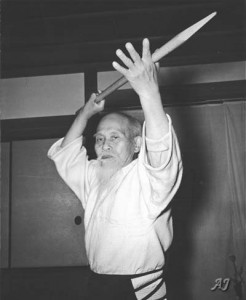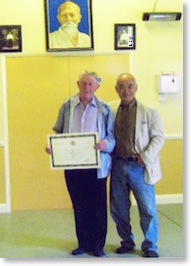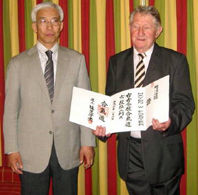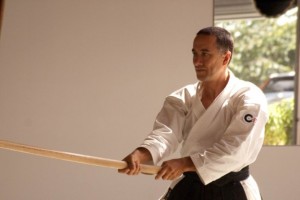Morihei Ueshiba (1883 – 1969) ‘O Sensei’ (“Great Teacher”)
Called O Sensei (“great teacher”), the founder of modern Aikido, was born on December 14, 1883 in the Wakayama Prefecture of Japan. Several incidents in his life served to shape his vision and beliefs, and influenced his design of a martial art that is, in many ways, unlike any other practised today.
As a small child, he saw his father attacked and assaulted by political opponents, and because of this injustice, devoted himself to becoming physically powerful. He studied under masters in several traditional forms of the martial arts. He became an expert in the styles of jujitsu (unarmed combat), kenjitsu (sword fighting), and sojitsu (spear fighting). O’Sensei would later incorporate elements of these styles into modern Aikido.
Despite his physical prowess, he found himself dispirited. He turned to studying various religions and philosophies in the hope of finding a deeper meaning and significance to life. In his search, he discovered and became a devotee of the religion called Omotokyo – a blend of neo-shintoism and socio-political idealism – where the unification of all humanity is one goal. He reached the conclusion that it was important to train people’s minds and spirits as well as their bodies.
O Sensei credited an incident with a naval officer as the beginning of his enlightenment. The officer, who was a fencing instructor, challenged him to a match. During the match, an unarmed O Sensei repeatedly evaded the officer’s strikes with a wooden sword, eventually defeating him when the officer dropped from exhaustion. In his retelling of the incident, O Sensei stated he was aware that could “see” the officer’s moves before he made them. He also realized that he had defeated an armed attacker without ever harming or even laying a hand on him.
Originally called aikibudo by its founder, this art that expressed O Sensei’s philosophy of harmony, protection and love, had a large number of followers by the early 1920’s. In 1927 O Sensei built a dojo in Tokyo. A few years later he founded the Budo Enhancement Society and became its chief instructor. In the early 1940’s his creation was being called Aikido, but it was still only practiced by carefully chosen individuals in Japan. After WWII, Aikido was introduced to the world, and gradually spread, reaching the United States in the late 1950’s.
O Sensei was a man of peace who followed his spiritual and philosophical vision. He taught that the martial arts should be used as a means to live in harmony with oneself, the earth, and its inhabitants. Throughout his life he continued to refine his system to the less violent and gently flowing techniques practised today. O Sensei died at the age of 86 on April 26, 1969.
Kenshiro Abbe Sensei (Dec 15th 1915 – Dec 1 1985)
Abbe Sensei had begun his martial arts career at the age of five and became a legend in his own lifetime. At eighteen he was the youngest ever all Japan Judo champion and also the youngest ever 5th Dan at the world renowned Kodokan. He later became the oldest ever all Japan Judo champion at the age of thirty three.
When Abbe Sensei arrived in the UK in 1955 he was 8th Dan Judo, 6th Dan Karate, 6th Dan Kendo, 6th Dan Kyudo, 6th Dan Aikido, In 1957 Abbe Sensei received a letter from Morihei Ueshiba stating that all instructors outside of Japan now had permission to teach aikido to anyone who wished to learn.
He was the first master in the UK to be allowed to teach aikido outside Japan as before that time the teaching of aikido was kept solely for the Japanese. He began teaching Aikido at the Abbe School of Budo, otherwise known as ‘The Hut’ dojo. One of the first students to learn Aikido from Abbe Sensei in the late 1950’s was Haydn W Foster.
H W Foster 7th dan Technical Director Institute of Aikido (8th May 1927-2011).
Sensei Foster was introduced to Aikido whilst taking his son to a judo class at the Hut dojo late in 1956. Whilst watching Abbe Sensei and his first two students, Ken and David Williams practising, something about the grace and power of the movement struck a chord within him, and he soon joined this small core of ‘original” Abbe students that were to be the source of much UK Aikido for years to come.
Sensei Foster began his aikido training some time towards the end of 1956 / beginning of 1957 at the Hut Dojo, near Heathrow. He was awarded 1st Dan by Kenshiro Abbe Sensei in 1960, and 2nd Dan by Mutsuharu Nakazono Sensei in 1962, one of the oldest Hombu grading certificates in the UK. He was awarded 3rd Dan by Masamichi Noro Sensei in 1969.

 In 1973, following the demise of the Renown Aikido Society (1966-1969), Foster Sensei was approached by the ex- members and asked to reconstruct the society as the Institute of Aikido. In June 2007, Sensei’s and students from many different organisations gathered together for a major UK course to honor and celebrate Mr. Foster’s 50th year in Aikido and his 80th Birthday.
In 1973, following the demise of the Renown Aikido Society (1966-1969), Foster Sensei was approached by the ex- members and asked to reconstruct the society as the Institute of Aikido. In June 2007, Sensei’s and students from many different organisations gathered together for a major UK course to honor and celebrate Mr. Foster’s 50th year in Aikido and his 80th Birthday.
On 26th August 2009 at The Hut dojo, our Technical Director Mr. H. Foster (7th Dan IA) was recognised for his commitment and achievements in Aikido with the award of 6th Dan in the International BiranKai by TK Chiba Shihan. Sadly Sensei Foster passed away in February 2011, aged 83. A huge loss to the worldwide Aikido community – he will be greatly missed by us all.
Dunken Francis Sensei 6th dan (23rd April 1964)
“My family moved house to West London, and soon realized that there was a martial arts club being run from the big old shed behind the Pub at the end of the road. In an attempt to burn off some of our excess energy my brother and I were quickly introduced to the Saturday morning kids classes. This was early 1974, the legendary Hut Dojo (birthplace of Aikido in the UK) and the start of my fascination with Aikido.
I trained for about 5 years as a child, mainly under various the yudansha that would take it in turns to teach the kids classes, but occasionally sensei Foster, the head honcho, or as most people referred to him “The Boss” or “The Guv’nor” would show up, and I remember being hugely impressed with him, how he moved and the energy he created on the mat. Sensei Foster (7th dan IA, 6th dan Aikikai) was one of the original group that started Aikido in the UK under Kenshiro Abbe sensei and it was my honour to eventually become his uke, assistant and friend.
For a man with one lung (removed in his 20’s after a severe bout of Pleurisy) he was amazingly nimble and moved with a fluidity and groundedness rarely seen, and also produced a incredible power for a small man. In his later years he was susceptible to regular winter chest infections so it fell to me to cover the majority of the classes, and it was here that I first started regularly teaching.
From the first time I picked up a bokken I could feel how useful a tool this would be to me, not only for physical conditioning but as a feedback process, allowing me to examine my posture, stance, movement and structure in the kind of detail that would be much harder otherwise. Using the Jo also allowed me to see an exaggerated version of my body movement and gave valuable insights into the core principles of Aikido, concentration upon ones centre, natural extension, weight underside and relaxation. As such I have always considered my Aiki training to be composed of three parts, tai-jutsu, bokken and jo.
I studied Wing Chun Kung Fu under master Derek Jones in London for about 3 and half years whilst I was at university, and
I have always been keen to cross-train with anyone who would let me on the mat, but most of my life has been dedicated
to exploring, promoting and studying Aikido and I have been lucky enough to teach and train all over the world.
I emigrated to New Zealand in 2005 and our new organisation, The Institute of Aikido International is proud to have
some superb clubs affiliated to it, including my Auckland and Silverdale dojos. Our doors are always open!”
Mainly focusing upon teaching beginners and trying to bring new people into the art, and to help newcomers clarify the myriad of techniques and technical terms used in our art, “Aikido – A Beginner’s Guide” was published in July 2003, and the accompanying DVD “Aikido – The First Steps” in 2005.